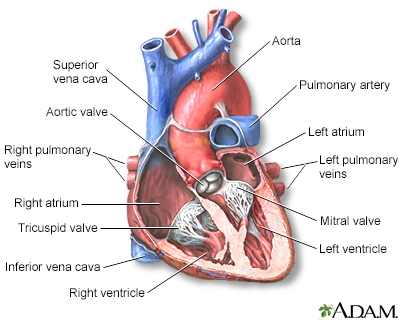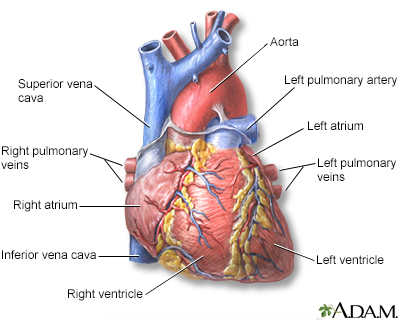Restrictive cardiomyopathy
Cardiomyopathy - restrictive; Infiltrative cardiomyopathy; Idiopathic myocardial fibrosis
Restrictive cardiomyopathy refers to a set of changes in how the heart muscle functions. These changes cause the heart to fill poorly (more common) or squeeze poorly (less common). Sometimes, both problems are present.
Images


Causes
In a case of restrictive cardiomyopathy, the heart muscle is of normal size or slightly enlarged. Most of the time, it also pumps normally. However, it does not relax normally during the time between heartbeats when the blood returns from the body (diastole).
Although the main problem is abnormal filling of the heart, the heart may not pump blood strongly when the disease progresses. The abnormal heart function can affect the lungs, liver, and other body systems. Restrictive cardiomyopathy may affect either or both of the lower heart chambers (ventricles). Restrictive cardiomyopathy is a rare condition. The most common causes are amyloidosis and scarring of the heart from an unknown cause. It also can occur after a heart transplant.
Other causes of restrictive cardiomyopathy include:
- Cardiac amyloidosis
- Carcinoid heart disease
- Diseases of the heart lining (endocardium), such as endomyocardial fibrosis and Loeffler syndrome (rare)
- Iron overload (hemochromatosis)
- Sarcoidosis
- Scarring after radiation or chemotherapy
- Scleroderma
- Tumors of the heart
Symptoms
Symptoms of heart failure are most common. These symptoms often develop slowly over time. However, symptoms sometimes start very suddenly and are severe.
Common symptoms are:
- Cough
- Breathing problems that occur at night, with activity or when lying flat
- Fatigue and inability to exercise
- Loss of appetite
- Swelling of the abdomen
- Swelling of the feet and ankles
- Uneven or rapid pulse
Other symptoms may include:
- Chest pain
- Inability to concentrate
- Low urine output
- Need to urinate at night (in adults)
Exams and Tests
A physical exam may show:
- Enlarged (distended) or bulging neck veins
- Enlarged liver
- Lung crackles and abnormal or distant heart sounds in the chest heard through a stethoscope
- Fluid backup into the hands and feet
- Signs of heart failure
Tests for restrictive cardiomyopathy include:
- Cardiac catheterization and coronary angiography
- Chest CT scan
- Chest x-ray
- Electrocardiogram (ECG)
- Echocardiogram and Doppler study
- MRI of the heart
- Nuclear heart scan (MUGA, RNV, PET)
- Serum iron studies
- Serum and urine protein tests
Restrictive cardiomyopathy may appear similar to constrictive pericarditis. Cardiac catheterization may help confirm the diagnosis. Rarely, a biopsy of the heart may be required.
Treatment
The condition causing the cardiomyopathy is treated when it can be found.
Few treatments are known to work well for restrictive cardiomyopathy. The main goal of treatment is to control symptoms and improve quality of life.
The following treatments may be used to control symptoms or prevent problems:
- Blood thinning medicines
- Chemotherapy (in some situations)
- Diuretics to remove fluid and help improve breathing
- Medicines to prevent or control abnormal heart rhythms
- Chemotherapeutic agents
- Medicines such as tafamidis that target abnormal proteins (amyloid fibrils)
- Liver transplantation
Additional treatments are also under investigation.
A heart transplant may be considered if the heart function is very poor and symptoms are severe.
Outlook (Prognosis)
People with this condition often develop heart failure that gets worse. Problems with heart rhythm or "leaky" heart valves may also occur.
People with restrictive cardiomyopathy may be heart transplant candidates. The outlook depends on the cause of the condition, but it is usually poor. Survival after diagnosis may exceed 10 years.
When to Contact a Medical Professional
Contact your health care provider if you have symptoms of restrictive cardiomyopathy.
Related Information
Muscle crampsReferences
Elliott PM, Olivotto I. Diseases of the myocardium and endocardium. In: Goldman L, Cooney KA, eds. Goldman-Cecil Medicine. 27th ed. Philadelphia, PA: Elsevier; 2024:chap 47.
Heidenreich PA, Bozkurt B, Aguilar D, et al. 2022 AHA/ACC/HFSA guideline for the management of heartfailure: a report of the American College of Cardiology/American Heart Association Joint Committee on Clinical Practice Guidelines. J Am Coll Cardiol. 2022;79(17):1757-1780. PMID: 35379504 pubmed.ncbi.nlm.nih.gov/35379504/.
Hershberger RE. The dilated, restrictive, and infiltrative cardiomyopathies. In: Libby P, Bonow RO, Mann DL, Tomaselli GF, Bhatt DL, Solomon SD, eds. Braunwald's Heart Disease: A Textbook of Cardiovascular Medicine. 12th ed. Philadelphia, PA: Elsevier; 2022:chap 52.
BACK TO TOPReview Date: 5/27/2024
Reviewed By: Michael A. Chen, MD, PhD, Associate Professor of Medicine, Division of Cardiology, Harborview Medical Center, University of Washington Medical School, Seattle, WA. Also reviewed by David C. Dugdale, MD, Medical Director, Brenda Conaway, Editorial Director, and the A.D.A.M. Editorial team.

Health Content Provider
06/01/2025
|
A.D.A.M., Inc. is accredited by URAC, for Health Content Provider (www.urac.org). URAC's accreditation program is an independent audit to verify that A.D.A.M. follows rigorous standards of quality and accountability. A.D.A.M. is among the first to achieve this important distinction for online health information and services. Learn more about A.D.A.M.'s editorial policy, editorial process and privacy policy. A.D.A.M. is also a founding member of Hi-Ethics. This site complied with the HONcode standard for trustworthy health information from 1995 to 2022, after which HON (Health On the Net, a not-for-profit organization that promoted transparent and reliable health information online) was discontinued. |
The information provided herein should not be used during any medical emergency or for the diagnosis or treatment of any medical condition. A licensed medical professional should be consulted for diagnosis and treatment of any and all medical conditions. Links to other sites are provided for information only -- they do not constitute endorsements of those other sites. © 1997- 2025 A.D.A.M., a business unit of Ebix, Inc. Any duplication or distribution of the information contained herein is strictly prohibited.
